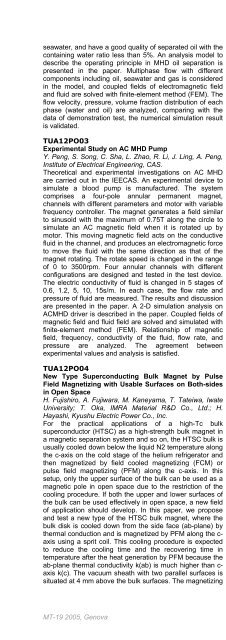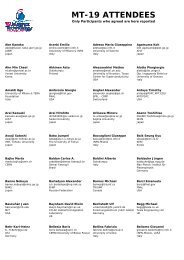Click here to download the abstract booklet in pdf format - MT19 - Infn
Click here to download the abstract booklet in pdf format - MT19 - Infn
Click here to download the abstract booklet in pdf format - MT19 - Infn
Create successful ePaper yourself
Turn your PDF publications into a flip-book with our unique Google optimized e-Paper software.
seawater, and have a good quality of separated oil with <strong>the</strong><br />
conta<strong>in</strong><strong>in</strong>g water ratio less than 5%. An analysis model <strong>to</strong><br />
describe <strong>the</strong> operat<strong>in</strong>g pr<strong>in</strong>ciple <strong>in</strong> MHD oil separation is<br />
presented <strong>in</strong> <strong>the</strong> paper. Multiphase flow with different<br />
components <strong>in</strong>clud<strong>in</strong>g oil, seawater and gas is considered<br />
<strong>in</strong> <strong>the</strong> model, and coupled fields of electromagnetic field<br />
and fluid are solved with f<strong>in</strong>ite-element method (FEM). The<br />
flow velocity, pressure, volume fraction distribution of each<br />
phase (water and oil) are analyzed, compar<strong>in</strong>g with <strong>the</strong><br />
data of demonstration test, <strong>the</strong> numerical simulation result<br />
is validated.<br />
TUA12PO03<br />
Experimental Study on AC MHD Pump<br />
Y. Peng, S. Song, C. Sha, L. Zhao, R. Li, J. L<strong>in</strong>g, A. Peng,<br />
Institute of Electrical Eng<strong>in</strong>eer<strong>in</strong>g, CAS.<br />
Theoretical and experimental <strong>in</strong>vestigations on AC MHD<br />
are carried out <strong>in</strong> <strong>the</strong> IEECAS. An experimental device <strong>to</strong><br />
simulate a blood pump is manufactured. The system<br />
comprises a four-pole annular permanent magnet,<br />
channels with different parameters and mo<strong>to</strong>r with variable<br />
frequency controller. The magnet generates a field similar<br />
<strong>to</strong> s<strong>in</strong>usoid with <strong>the</strong> maximum of 0.75T along <strong>the</strong> circle <strong>to</strong><br />
simulate an AC magnetic field when it is rotated up by<br />
mo<strong>to</strong>r. This mov<strong>in</strong>g magnetic field acts on <strong>the</strong> conductive<br />
fluid <strong>in</strong> <strong>the</strong> channel, and produces an electromagnetic force<br />
<strong>to</strong> move <strong>the</strong> fluid with <strong>the</strong> same direction as that of <strong>the</strong><br />
magnet rotat<strong>in</strong>g. The rotate speed is changed <strong>in</strong> <strong>the</strong> range<br />
of 0 <strong>to</strong> 3500rpm. Four annular channels with different<br />
configurations are designed and tested <strong>in</strong> <strong>the</strong> test device.<br />
The electric conductivity of fluid is changed <strong>in</strong> 5 stages of<br />
0.6, 1.2, 5, 10, 15s/m. In each case, <strong>the</strong> flow rate and<br />
pressure of fluid are measured. The results and discussion<br />
are presented <strong>in</strong> <strong>the</strong> paper. A 2-D simulation analysis on<br />
ACMHD driver is described <strong>in</strong> <strong>the</strong> paper. Coupled fields of<br />
magnetic field and fluid field are solved and simulated with<br />
f<strong>in</strong>ite-element method (FEM). Relationship of magnetic<br />
field, frequency, conductivity of <strong>the</strong> fluid, flow rate, and<br />
pressure are analyzed. The agreement between<br />
experimental values and analysis is satisfied.<br />
TUA12PO04<br />
New Type Superconduct<strong>in</strong>g Bulk Magnet by Pulse<br />
Field Magnetiz<strong>in</strong>g with Usable Surfaces on Both-sides<br />
<strong>in</strong> Open Space<br />
H. Fujishiro, A. Fujiwara, M. Kaneyama, T. Tateiwa, Iwate<br />
University; T. Oka, IMRA Material R&D Co., Ltd.; H.<br />
Hayashi, Kyushu Electric Power Co., Inc.<br />
For <strong>the</strong> practical applications of a high-Tc bulk<br />
superconduc<strong>to</strong>r (HTSC) as a high-strength bulk magnet <strong>in</strong><br />
a magnetic separation system and so on, <strong>the</strong> HTSC bulk is<br />
usually cooled down below <strong>the</strong> liquid N2 temperature along<br />
<strong>the</strong> c-axis on <strong>the</strong> cold stage of <strong>the</strong> helium refrigera<strong>to</strong>r and<br />
<strong>the</strong>n magnetized by field cooled magnetiz<strong>in</strong>g (FCM) or<br />
pulse field magnetiz<strong>in</strong>g (PFM) along <strong>the</strong> c-axis. In this<br />
setup, only <strong>the</strong> upper surface of <strong>the</strong> bulk can be used as a<br />
magnetic pole <strong>in</strong> open space due <strong>to</strong> <strong>the</strong> restriction of <strong>the</strong><br />
cool<strong>in</strong>g procedure. If both <strong>the</strong> upper and lower surfaces of<br />
<strong>the</strong> bulk can be used effectively <strong>in</strong> open space, a new field<br />
of application should develop. In this paper, we propose<br />
and test a new type of <strong>the</strong> HTSC bulk magnet, w<strong>here</strong> <strong>the</strong><br />
bulk disk is cooled down from <strong>the</strong> side face (ab-plane) by<br />
<strong>the</strong>rmal conduction and is magnetized by PFM along <strong>the</strong> c-<br />
axis us<strong>in</strong>g a sprit coil. This cool<strong>in</strong>g procedure is expected<br />
<strong>to</strong> reduce <strong>the</strong> cool<strong>in</strong>g time and <strong>the</strong> recover<strong>in</strong>g time <strong>in</strong><br />
temperature after <strong>the</strong> heat generation by PFM because <strong>the</strong><br />
ab-plane <strong>the</strong>rmal conductivity k(ab) is much higher than c-<br />
axis k(c). The vacuum sheath with two parallel surfaces is<br />
situated at 4 mm above <strong>the</strong> bulk surfaces. The magnetiz<strong>in</strong>g<br />
mechanism and <strong>the</strong> technical development for this type<br />
bulk magnet are discussed and compared with those of <strong>the</strong><br />
bulk magnet which utilizes only <strong>the</strong> upper surface of <strong>the</strong><br />
bulk.<br />
TUA12PO05<br />
Removal of Aerosol by Magnetic Separation<br />
H. Okada, H. Okuyama, M. Uda, N. Hirota, NIMS.<br />
Aerosol means suspended f<strong>in</strong>e liquid or solid particles with<br />
a diameter from 1 nm <strong>to</strong> 100 mm <strong>in</strong> gas. Removal<br />
techniques of aerosol cont<strong>in</strong>ue <strong>to</strong> be very important for a<br />
long time because f<strong>in</strong>e particles <strong>in</strong> exhaust gas of cars and<br />
fac<strong>to</strong>ry smoke are environment problems that are closest<br />
for us. Recently removal or captur<strong>in</strong>g techniques of nanoparticles<br />
are widely noticed from nano-technology, <strong>to</strong>o.<br />
They have <strong>to</strong> capture and separate nano-particles without<br />
damag<strong>in</strong>g characteristics <strong>in</strong> any environment and condition,<br />
subsequently <strong>to</strong> fabricat<strong>in</strong>g nano-particles. We exam<strong>in</strong>ed<br />
high gradient magnetic separation experiments of iron<br />
(ferromagnetic) nano-particles with a nom<strong>in</strong>al diameter of<br />
30 nm by a superconduct<strong>in</strong>g magnet. In <strong>the</strong> experiment we<br />
fabricated f<strong>in</strong>e iron particles by <strong>the</strong>rmal reactive plasma<br />
method <strong>in</strong> argon and hydrogen mixed gas and sent <strong>the</strong>m <strong>to</strong><br />
<strong>the</strong> magnetic separa<strong>to</strong>r directly. We present experimental<br />
results, functions of capture ratio on magnetic field and<br />
velocity of flow and so on. We conclude that high gradient<br />
magnetic separation is useful for nano-technology.<br />
TUA12PO06<br />
Industrial applications of HTSC coils us<strong>in</strong>g next<br />
generation BSCCO wire<br />
T. Okazaki, K. Okura, T. Ka<strong>to</strong>, K. Hayashi, K. Sa<strong>to</strong>,<br />
Sumi<strong>to</strong>mo Electric Industries.<br />
Two examples of <strong>in</strong>dustrial applications of High-<br />
Temperature Superconduct<strong>in</strong>g (HTS) magnets/coils are<br />
presented. These applications employ newly developed<br />
“Drastically Innovative Bismuth-based HTS wire (DI-<br />
BSCCO wire)” which is commercially available us<strong>in</strong>g<br />
Sumi<strong>to</strong>mo Electric’s <strong>in</strong>novative fabrication process called<br />
Controlled-Over Pressure (CT-OP) s<strong>in</strong>ter<strong>in</strong>g. The first<br />
application is <strong>the</strong> HTS coils for an electrical propulsion<br />
mo<strong>to</strong>r of a ship. The mo<strong>to</strong>r is designed <strong>to</strong> be used at <strong>the</strong><br />
liquid nitrogen temperature <strong>to</strong> acquire economical<br />
operat<strong>in</strong>g conditions and durability. This mo<strong>to</strong>r employs<br />
iron cores <strong>to</strong> reduce magnetic field at <strong>the</strong> coils. Installation<br />
of air gaps hold off <strong>the</strong> saturation issue of iron cores. This<br />
mo<strong>to</strong>r has successfully demonstrated its performance <strong>in</strong> a<br />
test tank. The second application of <strong>the</strong> HTS coil is a cryocooler<br />
cooled high-field magnet for analysis and research<br />
works. Increas<strong>in</strong>g applications of high-field magnetic field<br />
require handy and economical operat<strong>in</strong>g magnets. This<br />
magnet has a room temperature bore of 200mm and<br />
consists of 40km of DI-BSCCO wire. Two DI-BSCCO wires<br />
are bundled and wound <strong>in</strong> double-pancake shape without<br />
sta<strong>in</strong>less steel enforcement. The DI-BSCCO wire has<br />
almost <strong>the</strong> same tensile strength as that of <strong>the</strong> usual<br />
copper wire. This condition is expla<strong>in</strong>ed by existence of<br />
almost perfectly compressed superconduct<strong>in</strong>g filaments.<br />
This improved wire strength enables easier w<strong>in</strong>d<strong>in</strong>g and<br />
stronger coil characteristics.<br />
TUA12PO07<br />
3D Electromagnetic Analysis of Levitat<strong>in</strong>g Transporter<br />
us<strong>in</strong>g Bulk Superconduc<strong>to</strong>r<br />
H. Ueda, S. Tsuchiya, S. Azumaya, A. Ishiyama, Waseda<br />
University.<br />
It is possible that <strong>the</strong> bulk superconduc<strong>to</strong>r (HTS bulk) is<br />
levitated without any fixed mechanical guides by <strong>the</strong><br />
permanent magnet or electromagnet after a field-cool<strong>in</strong>g<br />
MT-19 2005, Genova 80



